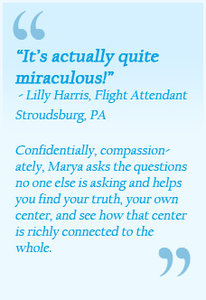PAIN, PRANA AND THE BLISS BODY

Yoga on the Mat: Pain, Prana & the Bliss Body
While pain is not one of my favorite subjects, I happen to know quite a bit about it. In fact, I’m writing this very moment with only one hand while a broken thumb throbs in a nest of ice beside me.
We all know more about pain than we’d like. Pain is an interesting subject in Yoga because the desire for pain relief is what brings many of us to the mat. As a Yoga Teacher in Hawaii, I’m lucky because most people in my classes want to feast on the blessings of inner and outer Paradise. If they want more pain rather than less, other Yoga classes can offer the needed cup of torment.
Still, who hasn’t bemoaned pain’s surge of hot muscular thunder and alarm in the brain? My sore thumb gives me pause at the pain-pleasure threshold to look at the bummer-benefit ratio of things that hurt. Remember what Jesus of Nazareth said in the Gnostic Gospels? “Learn to suffer and you will no longer need to suffer.” The Buddha? “Life is suffering.” And it leads to enlightenment.
What did they know that we usually don’t? Suffering consciously is not wallowing in pain. It is asking pain and anguish to yield their life lessons so we can move through the resistance to bliss and preventing future pain for everyone and every sentient being.
When I teach Yoga, I remind students that the fear of pain is not a wise master. Pain, however, can teach us what we need to know to reconnect with Prana and ride the supreme sweetness of the life force into contentment.
Simply put, there are two kinds of pain: sharp and achy. Stop doing anything that elicits sharp pain, which usually indicates an inflammatory condition and too much movement will lead to more irritation. Achy pain is more malleable, more like a discomfort, an anxiety. Yoga stretches may provide some achy discomfort, but if we persevere and learn its life lesson, we can relieve both kinds of pain.
Working with the body, not against it, not resisting it, the aim is to infuse the body with energy from the invisible field of Prana, which flows into the body during Yoga practice through the breath, posture, mantra, chant and visualization. Prana purifies the body, improves mobility, restructures cells and recharges the bio-electrical field.
Shifts in the body, while not always comfortable, may be necessary to heal, grow and transform, but it’s essential that we understand the difference between acceptable discomfort and unacceptable pain.
Conscious effort to move Prana into an area while stretching the body will sometimes produce an achy, smooth discomfort or anxiety, but it’s not pain. It’s on the threshold of pain; you can feel you’re releasing deeper obstructions. Continuing to breathe deeply through mild discomfort can guide us into better flow, alignment and higher-frequency vital energy.
In yoga, there is only one human body; however, there are five sheathes making up the aura. These layers of interweaving energy vibrate at different frequencies. The finer layers, or higher-frequency layers, culminate in what we call the Bliss Body – the Anandamaya Kosha – which affects and shapes the lower-frequency layers. As higher frequency subtle wave patterns shift, they reach into the physical layer, which pulses at the lowest frequency. This is a demonstration of the principle in the Shiva Sutras where it says, “As it is above, so it is below.”
In Gentle Yoga, we move the body in all its aspects, paying attention to sensation, energy, thought and imagination. As we breathe gently into muscle and mind, we find “threshold” areas where Pranic movement through a tight cluster of density lands you face-to-fascia with a fearful knot of old injury or diseased tissue.
Prana expressing through this tenderness can unexpectedly open up a pool of old and unwanted pain. If you are mindful, and find that it’s not really pain, but a twinge of worry, or a clenched muscle wanting to relax, you can find a melting point. The knotted complex will release and transform into biological bliss, a sensation of flow and perfect ease.
So how do Yogis resolve the pain of something like a broken thumb? We adapt. We become creative. We change our practice, movement, habit or thought form to come alive from a deeper place, at a higher vibration, in more coherent alignment with the highest of energies. When Prana enters the thumb, according to the ancient yoga sages, it connects me – us — to the Bliss Body, the True Self, which heals the pain.
The pain or discomfort is either an obstruction, or in some cases, an excess, of Prana. Balancing the flow at this point regenerates and renews life force integrity.
The balance for me involved realizing that when I broke my thumb, I was giving too much to others. I felt depleted. My low-energy state made me lift more than I should. If felt if I didn’t do even more, I would be “sticking out like a sore thumb.” With steady and loving inquiry, my Higher Self finally said, “Why just fit in when you were born to stand out?” I had to laugh and admit that no two paths are alike, and maybe my broken thumb was bringing the work of yoga and writing deeper into my bones. Humor and encouragement, where before there had been only pain and judgement, assured me that I had entered the realm of the Bliss Body.
Clearing the mind and body, learning the life lesson and bringing a higher-frequency consciousness into the cells come first. Doing the detective work of finding the deeper or higher-frequency source and resolving it comes second. Much pain is physical, but fear of pain is an emotional issue, not a physical one. Thoughts about pain can lodge in the mental sheathe and beliefs about pain are a spiritual issue. They can also reflect reactions and judgments about pleasure.
Yoga is an art and science that engages us on all levels. Emotions reside in the Manamaya Kosha, the sheath that carries how we ‘feel’ about our bodies, interactions and the world around us. It is the layer that starts to put our thoughts into action by feeling and experiencing the thought. Deep-seated beliefs and judgments are held in the next layer Vijnanamaya Kosha. These sheathes affect how we perceive our world. Our expectations, projections and joys are all colored by – or tainted by – our previous experiences lodged in these sheathes until we learn their life lessons and consciously choose to let them go.
Awareness through yoga opens up a larger perspective, an aspect of ourselves that doesn’t experience pain in the same excruciating way. We learn from it. We learn to flow like Prana, which can feel like the open space a songbird feels soaring on a summer day, or golden honey, flowing, glowing, soothing and sweetening.
Bringing those Prana-rich images into my body, I am amazed. My thumb feels better already! I’m writing with two hands! Two thumbs up!
Namaste!
Marya
Go here to learn about “Gentle Yoga for EveryBody” – www.maryamann.com/calendar/month-view/


